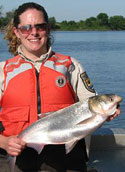Big
River Magazine
Mississippi
River stories and news
Big River Magazine
January-February 2012
Carp -- Queen of Rivers or Pig With Fins?
(Big River, Nov. 1993)
Stop carping and start cooking - recipes
and tips for cooking carp
(PDF, Big River, Sept. 2004)
carp info (just what you've always wanted)
Silver Carp These are the notorious “flying carp” on those unsettling YouTube videos. Like their cousins bighead carp, they are filter feeders, eating mostly algae, as well as zooplankton and detritus. Also like their cousins, their eyes are low on their heads. They are silver and look more streamlined than common carp. They were imported to remove algae from ponds on catfish farms in the South, but escaped into the Mississippi River watershed. They are a popular domesticated food fish in Asia. Their flesh is firm and white, with free-floating bones. In an effort to popularize them as a food in the United States, some have taken to calling them “silver fins." Helpful Links USFWS, La Crosse, Wis., Fisheries |
Common Carp Even though common carp is an invasive species, it’s been in North America for more than a century. It probably originated in Central Asia, but it’s hard to pinpoint, because common carp have been domesticated for thousands of years. It was first domesticated in Asia and was brought to Europe, where it spread quickly, even to Great Britain, where it is now a very popular game fish. When it spread in the other direction, into Japan, growers began selecting it for colors and patterns, developing it into the koi. Despite folklore, goldfish are a different species of carp. Common carp have whiskers, large scales and a blocky body. Their color and color patterns vary, but they are often olive green, black and/or brass colored. They eat a wide variety of foods, including plants and small animals. Their flesh is richer and darker than the other Asian carp. Flesh from females carp is usually preferred. It is a popular food in eastern and central Europe, often served as the main dish for Christmas or Christmas Eve dinner. It continues to be a very popular domesticated food fish in Asia. |


